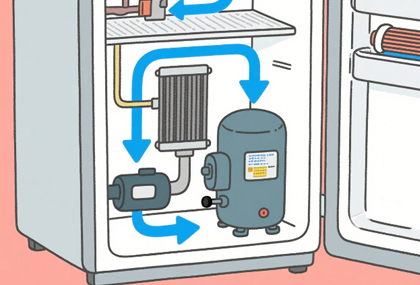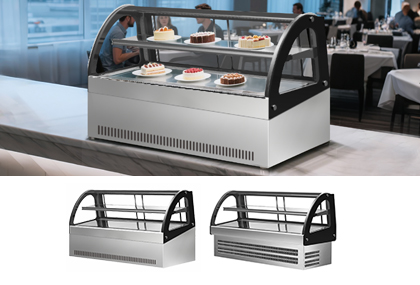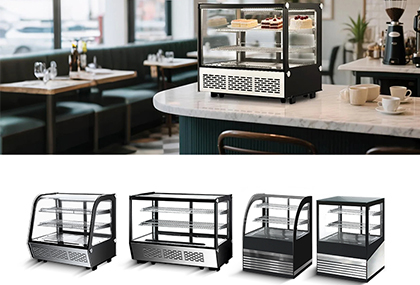Coffee Display Equipment Full Dimension Strategy
In the coffee consumption from "functional demand" to "experience consumption", display equipment has long exceeded the single property of "storage tool", and has become the core carrier to convey brand concepts, guarantee product quality, and enhance user decision-making efficiency. It has become the core carrier to convey brand concepts, guarantee product quality, and enhance users' decision-making efficiency. It is important to grasp its core value, selection skills, and avoid misunderstandings.
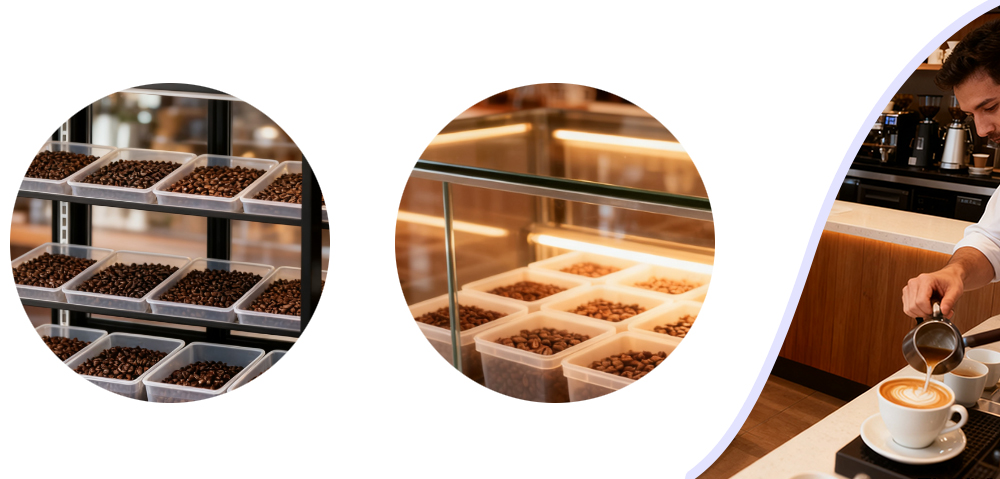
Ⅰ. Core value of scenario-based positioning devices
The primary criterion for selecting coffee display equipment is 'scenario compatibility' —even the best equipment becomes a waste of resources when divorced from its operational context. The core requirements of the following three typical scenarios differ significantly:
1. Culture transfer priority
By highlighting the 'professional touch' and 'storytelling' aspects, customers can intuitively appreciate the value of coffee.
- Key equipment: Coffee bean display rack, single bean sample cabinet, and hand brewer display rack
- Key indicators: Display visibility (e.g., transparent glass), atmosphere compatibility (consistent with interior design), freshness preservation (prevents coffee bean oxidation)
2. Efficiency and standards first
Ensure stable quality and controllable cost in large-scale operation, and maintain the consistency of brand image.
- Key equipment: Dual-zone refrigeration cabinet, smart dessert display cabinet, standardized raw material storage rack
- Key indicators: temperature control accuracy, energy consumption level, easy cleaning, batch adaptability
- Industry data: For chain brands using first-class energy-efficient refrigerators, the average annual energy cost per store can be reduced by 30%; equipment with self-cleaning function can reduce maintenance hours by 40%.
3. Convenient locations
Integrate display and sales in confined spaces, ideal for high-traffic, low-maintenance environments.
- Key equipment: compact raw material cabinet, built-in dessert rack, mobile coffee cart display stand
- Key metrics: floor space (e.g., mini display cabinets ≤0.5㎡), interference resistance (adapts to outdoor temperature fluctuations), and portability
- A prime example: The COFE + Coffee Robot integrated display cabinet occupies just 0.3㎡ while showcasing 65 types of ingredients, making it ideal for compact spaces like office buildings and tourist attractions.
Ⅱ. Three core dimensions of equipment selection
No matter what kind of equipment, it is impossible to avoid the three core dimensions of quality assurance, user experience and operation adaptation.
1. Quality assurance: safeguarding the core value of coffee
The core responsibility of the display equipment is to "maintain the best condition of the product", especially for the coffee raw materials and finished products that are sensitive to temperature and humidity.
- Temperature Control System: Customized solutions for different storage requirements. Fresh milk requires stable temperatures between 2-6℃, ice cream needs to be kept below-18℃, while cheesecake thrives in a moderate 8-12℃ environment. The dual-zone design optimally accommodates various ingredients, extending the shelf life of cream cheese by 30%. We recommend selecting inverter-controlled temperature controllers with ±0.5℃ precision to prevent quality degradation caused by temperature fluctuations.
- Humidity control: Coffee beans should be stored at 40%-60% humidity, while desserts should be displayed at 75%-85% humidity to prevent cracking. The display cabinet with ultrasonic humidification module can extend the shelf life of mousse cakes by more than 2 days.
- Material Safety: All food-contact surfaces must meet FDA standards. We recommend the cordierite ceramic inner liner with nano-silver coating, which achieves 99.9% antibacterial efficiency and is easy to clean with no residue. As the new national standard will ban R22 refrigerant in 2025, ensure your model uses eco-friendly refrigerants like R600a when purchasing.
2. Turn your presentation into a silent sales assistant
The key to reducing customer decision cost and even stimulating potential consumer demand lies in visual presentation and interaction design:
- Lighting Design: LED strips form the core setup, with color temperature selection tailored to product characteristics — 2700K warm white light accentuates the glossy oils of roasted beans, while 4000K natural light highlights the freshness of fresh fruit desserts. A color rendering index (CRI) ≥90Ra ensures accurate color reproduction of coffee beans, preventing visual distortion that might mislead customers.
- Optical transparency: For coffee bean displays, prioritize high-transparency glass (≥92% light transmittance). Dessert cabinets may feature transparent OLED glass doors, which not only enhance visual appeal but also enable real-time coupon distribution via mobile apps, thereby boosting conversion rates.
- Interactive adaptation: For premium scenarios, add smart query features such as displaying coffee bean production area maps and roasting dates on the touchscreen; for convenient scenarios, simplify the display logic by categorizing products into "best-sellers" and "regulars".
3. Balance cost and efficiency
The "hidden cost" of the equipment often determines the long-term benefits, and the purchase should be evaluated in terms of energy consumption, maintenance and space occupancy.
Energy efficiency rating: Commercial equipment should prioritize Class 1 energy efficiency. For example, the Haier BCD-216STPT model consumes only 0.68kW·h per day, saving nearly 1,000 yuan in annual electricity costs compared to Class 3 models.
Maintenance design: The modular structure facilitates component replacement and reduces downtime; the self-cleaning coating reduces the frequency of cleaning, especially suitable for stores with limited manpower.
Space utilization: The vertical display cabinet saves 40% of the floor space compared with the horizontal model, and the vertical storage can reach 12 standard raw material units, which is suitable for the community store with narrow space.
Ⅲ. Mainstream device scenario adaptation list
Different display devices have different functional focuses, and the maximum value can be achieved only by accurately matching categories.

IV. Avoid common mistakes in purchasing
Misconception 1: Focus on appearance while neglecting core functionality. Some trendy display racks lack moisture-proof design, causing coffee beans to lose flavor within a week. Prioritize freshness preservation.
Myth 2: Overemphasis on smart features. Non-chain stores don't need IoT monitoring systems—basic temperature control devices are sufficient, saving 30% on procurement costs.
Misconception 3: Neglecting after-sales service. For commercial equipment, choose brands offering a 2-year warranty plus 48-hour on-site repair to prevent business downtime caused by malfunctions.
V. Decision-making path from demand to implementation
- Define core scenarios: first determine whether it's a boutique or a convenience store, and whether it focuses on coffee beans or desserts, then lock in the equipment type.
- Lock key metrics: filter by priority parameters in the order of Quality Assurance (Temperature Control/Materials) → User Experience (Lighting/Transparency) → Operational Adaptation (Energy Consumption/Maintenance).
- Match the brand budget: choose the smart model to enhance the image in high-end scenarios, choose the cost-effective model to control the cost in small and medium-sized stores, and choose the customized model to meet the needs in special scenarios;
- Verify after-sales service capabilities: confirm warranty period, repair outlets and response speed to reduce long-term risks.
Cooluma emphasizes that the ultimate value of coffee presentation equipment lies in 'letting the product speak for itself' —whether it's the glossy appearance of coffee beans on bamboo or wooden shelves, or the rich, sweet texture preserved in refrigerators. High-quality presentation allows customers to intuitively perceive the brand's professionalism and dedication.
Most popular More «
-
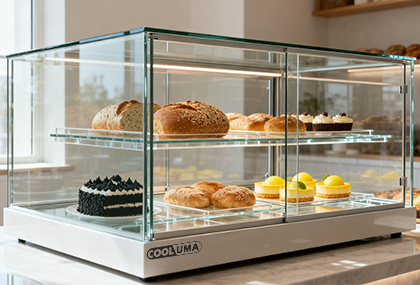
Why Are All-Glass Display Cases So Expensive?
-
Technical Parameters and Solutions for Commercial Cake Chillers
-
Coffee Display Equipment Full Dimension Strategy
-
Cooluma Best Countertop Cake Refrigerator
-
Commerical Bread Cabinet First-Time Use Step-by-Step Guide
-
How to choose a desktop cake supplier?
-
Ideal temperature and temperature control points of cake cabinet
-
Which Cooluma compact commercial cake display cabinet is the best?
-
What are the procedures required for the certification of food display cabinets?
-
Aims to be a global supplier of commercial cold chain equipment, Cooluma





